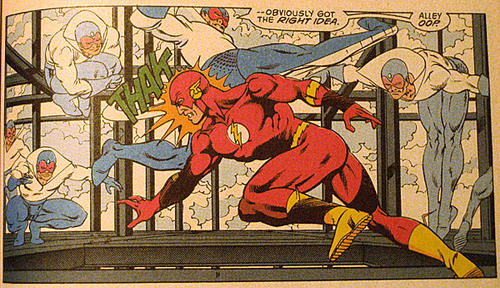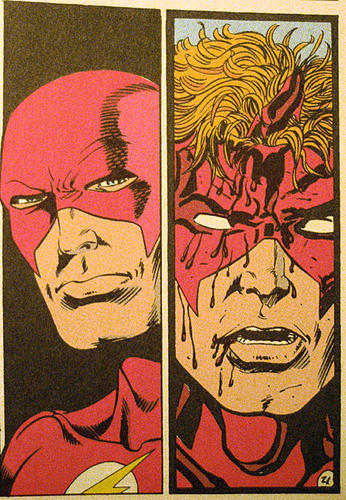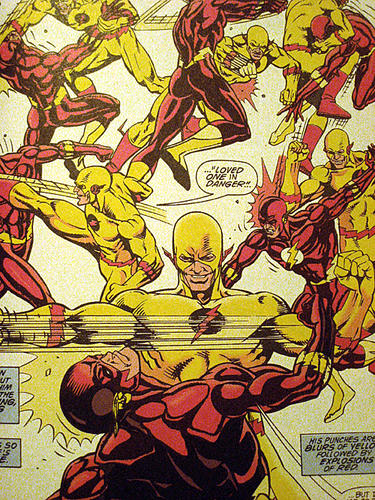Today’s guest post is the first in a series of interviews by Greg Elias on The Art of Speed.
In 1988, Wally West was powerless, penniless and nearly homeless. With Flash #15, the creative team of writer William Messner-Loebs and artist Greg LaRocque began their memorable take on the title. Throughout their run, Loebs and LaRocque established the touchstones of Wally’s life in Keystone City, including many of the character’s major themes and a supporting cast that remains vital. LaRocque was also on board when writer Mark Waid took over, starting with issue #62 in 1992. Wally West continued to bloom under Waid, reaching new levels of confidence and self-assuredness each month. Wally’s road back from that low point played out over five years and 64 issues.
Each and every benchmark during that time, including the landmark issue #50 and introduction of a new Flash costume, was seen through the eyes and pencils of LaRocque. Previously associated with a highly- regarded body of work on Legion of Super Heroes, his style would end up defining the Flash for longer than any artist since Carmine Infantino or Irv Novick.
Perhaps no storyline is more closely identified with the development of the Wally West character than 1993’s The Return of Barry Allen. Within, Wally is faced with the shocking apparent return of his deceased uncle and mentor, Barry Allen, the second Flash. This was LaRocque’s last stand on the title – his final run with the character he had drawn from the depths of poverty and doubt. We asked LaRocque about his work on the story, focusing on the construction and the subtleties of putting together a super-speed coming-of-age.

Q: One of the things that defines The Return of Barry Allen is the super-speed action sequences. You’ve got Johnny Quick and Max Mercury in the mix, along with Wally West, Jay Garrick and “Barry Allen”. Given the larger cast, and each character having the same power (and somewhat similar costumes), what were some of the challenges in constructing these memorable scenes? Was there an attempt to define each character’s own “style”?
GREG LAROCQUE: That is best demonstrated in the construction scene when Max Mercury teaches Zoom a lesson in technique. Mark wrote it out for me in the script & it was a challenge to visually portray the different ways the cast displayed their skills. With Max, he was all about grace & fluidity, like water, like mercury. Zoom ran & moved effortlessly because he was the fastest & gloating. Jay & Johnny were the traditional full speed ahead runners.
Quick note on Wally. I never drew him running. He GLIDES like an ice skater.
Q: How does planning around the environment in a comics scene differ when working with super-speed? You’ve got scenes in the Flash Museum, at a construction site, in an office building and other urban settings. Are these chosen for a reason beyond the story, like props, or were you left to pick the speed tricks and visualize what Flash would be capable of doing in each?
GL: Those choices are the writers. My goal is to make the environment as much a star as the characters visually, ensuring it works with the story telling & page design. Mark’s scripts are very tight with precise panel breakdowns. Bill’s plots were something totally different. I was given much more opportunity to expand on what he gave me, especially with the action.

Q: It’s not really speed-related, but the facial expressions and mannerisms of the characters in this story really ratchet up the tension, especially in the early going. In a story like this, which is driven by concepts like self-doubt, fear of replacement and hero-worship, what goes into portraying that subtlety of emotion?
GL: The role of a comic book artist is that of the director & the actor in a movie. Also set designer, casting agent, cinematographer, wardrobe person & virtually everything else. We start with a blank page & need to create a world that a writer has written for us. When it comes to portraying the soap opera aspect of story, it boils down to capturing a character & being able to portray his ‘acting’ in sequential story telling. Only study, practice & more study & practice enable any artist to pull this off. Any artist can learn from Eisner about storytelling & acting.
Q: From his return as “Barry” to the battles with Jay, Johnny, Max and GL, to the reveal and showdown with Wally: how did the physical portrayal of Barry/Zoom change during the course of his story arc? By the time he ends up in the Zoom uniform, he seems bigger and more sinewy, and his stance/motions more brutal and “charged” (for lack of a better word).
GL: Heroes pose with a certain look that defines who they are. Body language can tell a lot about who & what they are. Spider-man is the best example of this. He has a unique frame & style to him & his poses are inspired by the look of a Spider, crouching, arched, & in impossible positions. Superman is the chin up, square jawed classic heroic poser & Flash as I drew him was the athlete, not interested in the heroic pose unless script called for it, but cool pin up shots that showed creative action. When Zoom regained his memory I tried to show the insanity in his eyes & a more herky jerky, tense, uncomfortable body language. It’s nice to see people have noticed the subtle differences I incorporated. 😉

Q: Conversely, this was Wally’s big coming-of-age story. Without affecting the style you had established during your run, was there an attempt to make physical changes to Wally over the course of the story to reflect the regained speed and confidence, especially during the last issue?
GL: Little things, hunched shoulders early on became ‘Ready to Rumble’ body language later on. His sadness & confusion early on was replaced by a happy smile to end my run. It was great to leave Wally in such a good place.
Q: Since this was your last story on the Flash title, did you try and fit in any tricks or experiments that you had been holding onto for the finale?
Issue #79 was an oversized issue, and it seemed like you got to stretch out a little.
GL: I have to thank Mark for his work on ‘The Return of Barry Allen’. He put it all in the script for me.
Q: What is your favorite speed trick of all time?
GL: Neal Adams drew a Barry Allen Flash that ran to the moon & back. You gotta read it to believe it 😉

I loved “The Return of Barry Allen,” especially the underlying message of it – that we all thought we wanted Barry Allen back, but Wally had in many ways surpassed him. I have loads of respect for Geoff Johns but I think Barry is a character who should not have been revived. Wally was “my” Flash, and he earned the role. I might not have liked later Wally developments (the kids were kind of annoying) but I still enjoyed reading about him more than I’ve enjoyed reading the adventures of a returned Barry.
And Greg Larocque – what a fantastic penciller. Confession: I HATED Mike Wieringo’s artwork at first, but mostly because he replaced who at that time was my favorite Flash artist. I loved how under his pen, Wally’s costume was so shiny and different from what we’d seen before. I later came to love Wieringo – even purposely buying books if he drew them – but it was a big difference from the more traditional Larocque.
Thank you for posting this. 🙂
Great post! Thanks!
I started reading The Flash during Messner-Loebs & LaRocque’s run. I thought the highlight of that era was Wally’s “death” at the hands of Vandal Savage and his “resurrection” thanks to Kilg%re. I thought it was fitting that Wally’s run “ended” (well sort of “ended”) with another Vandal Savage story in Flash #232.
Speaking of Vandal Savage, where is that old codger? And have he and Ra’s Al Ghul ever teamed up? They’re likely closer in age to one another than they are or ever have been to anyone else in the DC Universe. Next to Zoom (and I actually do mean Zolomon, not Thawne. But the way Johns is writing Thawne he’s quickly becoming one of my favorite rogues) Savage is actually my favorite of the Flash rogues.
Bruce Timm needs to adapt this one.
“The Return of Barry Allen” is one of my all-time favourite Flash story arcs. Both the writing and art were absolutely phenomenal. The last issue of it was one of the best-drawn issues I had seen. I think I’ll re-read it over the holiday break.
It would make an awesome DCU animated movie, although it might have too much continuity baggage.
Great interview! Greg is one of my favorite Flash (and Legion!) artists.
Great little interview! Thanks for posting it.
The Return of Barry Allen is one of those stories that holds it’s age well and is still a favourite of mine.
I really miss Wally 🙁
Craig, I hear you. It took me til this story to fully love Wally, but he has been my favorite Flash ever since. I also love Johns, and while not thrilled that Barry has come back and displaced Wally, I very much appreciated when he wrote Wally telling Barry he was the Nightwing to his Batman and Barry replying that Wally was the Flash to his Flash.
I also dropped Flash foolishly after this issue, due to the departure of LaRocque and a few months later had to go back and pick up the Wieringo issues once I realized what I’d been missing! Very different styles but I have come to love them both equally.
The Flash is one of my favorite DC characters, be it Barry or Wally. Return of Barry Allen is one of the best Flash stories ever done. Of Waid’s material, I probably only like Terminal Velocity a *little* more. (Though I like Blitz and the Death of Iris Allen arc better than both of those.)
Killing Barry was fine with me, because Waid, Johns and Loebs told some pretty great stories about someone having to fill his shoes, and all the pitfalls that created made for interesting stories. And now that that story has been told – definitively, over the course of 15 or so years – it’s time to reinvent Barry again.
And provided that also makes for good stories, I say go for it. Which, going by the first arc of the new series, it seems like the Flash is in good hands.
Again.
Never been a fan of Return Of Barry Allen, it’s part of the reason why I could never connect to Waid’s run on Flash.
It basically had the opposite effect of what he was trying to get accross, it came accross as way too forced and trying too hard to cheerlead for Wally. Plus the whole bait and switch stuff DC used to try and pull every couple of years with Barry always pissed me off.
Thanks to Gregory Elias for a job well done 😉 & everyone else for their kind words.